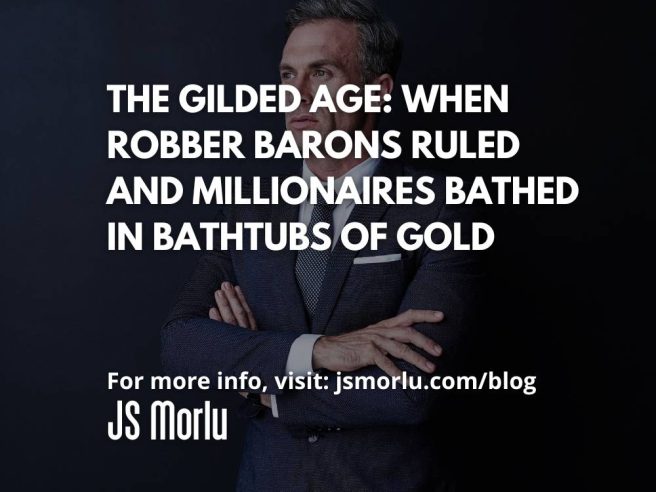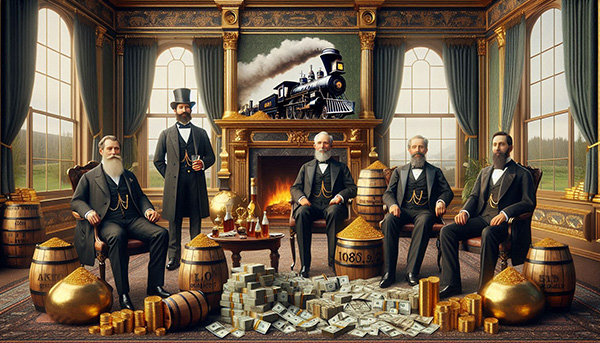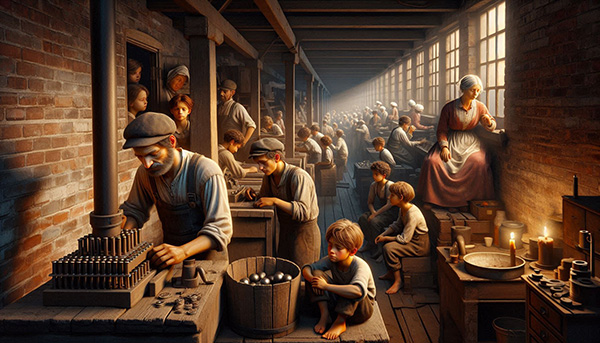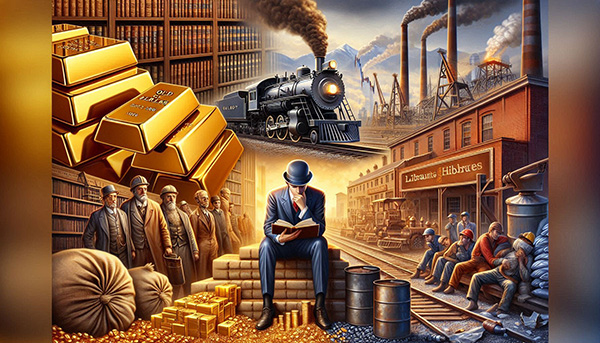By: John S. Morlu II, CPA
What Was the Gilded Age?
The Gilded Age (around the 1870s to the early 1900s) was like a magic trick. On the outside, it looked shiny, rich, and successful. America had booming factories, fancy railroads, and giant mansions. But on the inside, things were a mess—low wages, dangerous jobs, and people living in crowded, unhealthy homes.
The name “Gilded Age” was created by writer Mark Twain. “Gilded” means something is covered in gold on the outside, but it might be cheap or rotten underneath. Twain was basically saying: “America looks great, but don’t be fooled. It’s full of problems.”
Meet the Gilded Gang: The Real-Life Richest of the Rich
These men didn’t just make money—they printed it, stacked it, and slept on it. They built businesses so big they made the government look small. Let’s meet the main players.
1. Cornelius Vanderbilt – The Train and Boat Boss
Cornelius Vanderbilt started out poor. He quit school at 11 and began working on boats. Fast forward a few decades—he was building railroads and making hundreds of millions of dollars. He became one of the richest men in American history.
He built the New York Central Railroad, and if there was a train running in America, chances are he owned part of it.
Fun Fact: He once donated $1 million to start a university in Tennessee. They named it Vanderbilt University. Today, that would be like giving over $30 million—and not even blinking.
Cool But Scary Quote: “What do I care about the law? Ain’t I got the power?” In other words: “Laws are for broke people.”
2. Andrew Carnegie – The Steel Giant With a Library Card
Carnegie was born in Scotland and came to America as a poor immigrant. He worked his way up from factory jobs to owning Carnegie Steel Company. He made steel for railroads, buildings, and bridges. Steel was the backbone of America’s rise—and Carnegie was the blacksmith.
But here’s the twist: He believed that rich people should give away their money to help society. So he built over 2,500 libraries around the world.
Fun Fact: He sold his company to banker J.P. Morgan for $480 million in 1901 (that’s over $15 billion today). Then he spent the rest of his life writing about why the rich should give their money away.
Not-So-Fun Fact: While he gave away money for libraries, his workers were underpaid and worked in dangerous conditions. In one famous strike, some workers died while protesting.
If He Had Twitter: “Donated $10 million today. Also, my workers still don’t get bathroom breaks. #philanthropy”
3. John D. Rockefeller – The Oil Emperor
Rockefeller created Standard Oil Company and turned oil into a money fountain. At one point, he controlled about 90% of all oil in the U.S. He made deals, crushed rivals, and used smart tricks to beat the competition.
Fun Fact: He became America’s first billionaire. Adjusted for inflation, he may have been the richest person to ever live—richer than Elon Musk or Jeff Bezos today.
Interesting Tidbit: When the government said he had too much power, they broke up his company. That breakup created modern oil giants like ExxonMobil and Chevron.
Nicknamed: “The Richest Man in History” and sometimes “The Original Monopoly Man.”
4. J.P. Morgan – The Man Who Bought Everything, Including the Government
J.P. Morgan was a banker who looked like he could scare a bear with his eyebrows. But more importantly, he was powerful. So powerful that when the U.S. government ran out of money during a financial panic in 1895, he loaned them gold—$65 million worth.
Imagine if the government today couldn’t pay its bills, and Jeff Bezos bailed them out with Amazon gift cards.
Fun Fact: He helped create General Electric and U.S. Steel. He also bought Carnegie’s steel business to form the first billion-dollar company.
Interesting Detail: His nose was famously big, because of a skin condition. It became a popular joke in newspapers, but nobody joked to his face—because he basically owned the banks, the businesses, and the country.
5. Jay Gould – The Trickster of Wall Street
Jay Gould was known for playing dirty. He bought and sold railroads, stocks, and gold—always with a sneaky plan. In 1869, he and a partner tried to control the entire gold market. It caused a huge panic called Black Friday, and the economy crashed.
Fun Fact: He once controlled so many railroads, he could change the price of goods across the country just by saying so.
Modern Version of Jay Gould: That guy online who pumps and dumps crypto, except Gould crashed the whole economy for fun.
What About Regular People?
While these billionaires lived in castles, the average American worked 12–16 hours a day in unsafe factories. Kids as young as 7 or 8 worked in coal mines or textile mills.
Facts:
- No paid vacation
- No sick leave
- No safety rules
- No weekends (those were invented later!)
Families often lived in one-room apartments with no running water. Diseases spread quickly, and many people died young.
Stat Attack: In 1890, the top 1% of Americans had more wealth than the bottom 99% combined. That’s not a typo.
Politics: Brought to You by the Rich
During the Gilded Age, politicians were basically employees of the rich. Businessmen gave them “campaign donations” (a fancy word for bribes), and in return, the government passed laws that helped the rich get even richer.
Example: Boss Tweed of New York ran Tammany Hall, a political machine that handed out jobs and contracts like party favors. He stole millions while pretending to help the poor.
But It Wasn’t All Bad… Eventually
Even though the Gilded Age was wild, unfair, and corrupt, it sparked a fire for change.
- Labor unions started forming to fight for fair wages and safe workplaces.
- Investigative journalists, called muckrakers, exposed the dirty secrets of big business.
- In 1890, the government passed the Sherman Antitrust Act to break up monopolies.
This age set the stage for future reforms, like the 8-hour workday, child labor laws, and the modern middle class.
Final Wisdom
If you ever feel bad about not being a billionaire yet, just remember:
- Cornelius Vanderbilt built trains—but didn’t care who got run over.
- Rockefeller gave away billions—but didn’t give his workers toilet breaks.
- Carnegie built libraries—while breaking backs in steel mills.
- Jay Gould collapsed the economy—because he was bored.
- And J.P. Morgan saved the government—because he was the government.
Bonus Resources (a.k.a. Smart People Reading List):
- The Tycoons by Charles R. Morris
- The Gilded Age by Mark Twain & Charles Dudley Warner
- Titan: The Life of John D. Rockefeller, Sr. by Ron Chernow
- PBS Documentary: The American Experience – The Gilded Age
About the Author
John is an entrepreneur, strategist, and founder of JS Morlu, LLC, a Virginia based CPA firm with multiple software ventures including www.FinovatePro.com, www.Recksoft.com and www.Fixaars.com . With operations spanning multiple countries, John is on a mission to build global infrastructure that empowers small businesses, entrepreneurs, and professionals to thrive in an increasingly competitive world. He believes in hard truths, smart execution, and the relentless pursuit of excellence. When he’s not writing or building, he’s challenging someone to a productivity contest—or inventing software that automates it.
JS Morlu LLC is a top-tier accounting firm based in Woodbridge, Virginia, with a team of highly experienced and qualified CPAs and business advisors. We are dedicated to providing comprehensive accounting, tax, and business advisory services to clients throughout the Washington, D.C. Metro Area and the surrounding regions. With over a decade of experience, we have cultivated a deep understanding of our clients’ needs and aspirations. We recognize that our clients seek more than just value-added accounting services; they seek a trusted partner who can guide them towards achieving their business goals and personal financial well-being.
Talk to us || What our clients says about us




